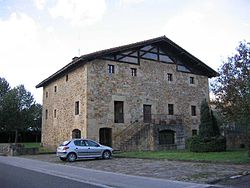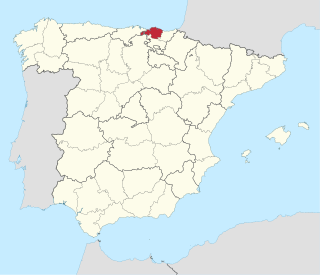
Biscay is a province of Spain and a historical territory of the Basque Country, heir of the ancient Lordship of Biscay, lying on the south shore of the eponymous bay. The capital and largest city is Bilbao.

Garai is an elizate, town and municipality located in the province of Biscay, in the Basque Country, Spain. Garai is part of the comarca of Durangaldea and has a population of 318 inhabitants as of 2009 according to the Spanish National Statistics Institute.
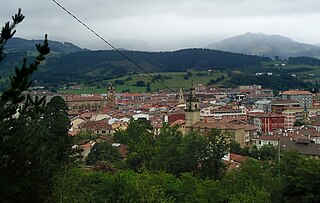
Durango is a town and municipality of the historical territory and province of Biscay, located in the Basque Country, Spain. It is the main town of Durangaldea, one of the comarcas of Biscay. Because of its economical activities and population, Durango is considered one of the largest towns in Biscay after the ones that compose the conurbation of Greater Bilbao.

Atxondo is a municipality located in the province of Biscay, in the Basque Country, Spain. Atxondo is part of the comarca of Durangaldea and has a population of 1,447 inhabitants as of 2007 according to the Spanish National Statistics Institute.

Abadiño is a town located in the province of Biscay, in the autonomous community of Basque Country, in the north of Spain, about 35 km from the provincial capital of Bilbao. The area of the municipality is about 36 km2 (13.9 sq mi) and according to the 2014 census, the population is 7504. The original name of the town was Abadiano Celayeta.

Elorrio is a town and a municipality located in the eastern part of the province of Biscay, in the Basque Country, in northern Spain. As of 2017, it has a population of 7,307 inhabitants. It covers an area of 37.20 square kilometers and it has a population density of 193.58 people per square kilometer. It holds the medieval title of Most Loyal and Noble Villa.

Izurtza is an elizate, town and municipality located in the province of Biscay, in the Basque Country, Spain. Izurtza is part of the comarca of Durangaldea and has a population of 270 inhabitants as of 2010 and according to the Spanish National Statistics Institute.

Mallabia is an elizate, town and municipality located in the province of Biscay, in the Basque Country, northern Spain. Mallabia is part of the comarca of Durangaldea and has a population of 1.135 inhabitants as of 2006 and according to the Spanish National Statistics Institute.

Mañaria is an elizate, town and municipality located in the province of Biscay, in the Basque Country, Spain. Mañaria is part of the comarca of Durangaldea and has a population of 459 inhabitants as of 2006 according to the Spanish National Statistics Institute.
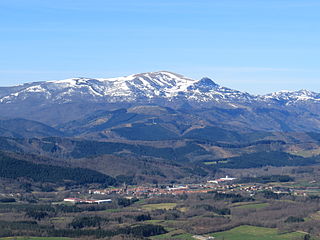
Otxandio is a town and municipality located in the province of Biscay, in the Basque autonomous community, Spain. Otxandio is part of the comarca of Durangaldea and has a population of 1,269 inhabitants as of 2010 according to the Spanish National Statistics Institute.
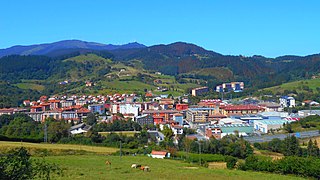
Zaldibar is an elizate, town and municipality located in the province of Biscay, in the Basque Country, Spain. Zaldibar is part of the comarca of Durangaldea and has a population of 3,043 inhabitants as of 2019 and according to the Spanish National Statistics Institute.

The Basques are an indigenous ethno-linguistic group mainly inhabiting the Basque Country. Their history is therefore interconnected with Spanish and French history and also with the history of many other past and present countries, particularly in Europe and the Americas, where a large number of their descendants keep attached to their roots, clustering around Basque clubs which are centers for Basque people.
Etxeberria (Basque pronunciation:[etʃeβeri.a], modern Basque spelling) is a Basque language placename and surname from the Basque Country in Spain and France, meaning 'the new house'. It shows one meaningful variant, Etxeberri (no Basque article –a, 'the'), and a number of later spelling variants produced in Spanish and other languages. Etxebarri(a) is a western Basque dialectal variant, with the same etymology. Etxarri (Echarri) is attested as stemming from Etxaberri.

The Southern Basque Country refers to the Basque territories within Spain as a unified whole.

The Basque jaurerriak or señoríos were a series of feudal territories that came into existence in the Basque Country in the Middle Ages. The lordships were hereditary land titles over territories of variable size under the name of a lord or count. The title and lands were often recognized by kings to Basque chieftains. It is loosely related to the concept of manorialism as the king had to swear allegiance to the Foral law in exchange for military assistance from the Basque chiefs, who were considered sovereign over their own lands and people. The Basque señoríos generally conformed vassal states of larger kingdoms; most of them started as domains of the Kingdom of Pamplona but were conquered and attached to the Kingdom of Castile by the 13th century. The Basque term jaurreria means "the lord's country" and it is usually used to refer to these feudal territories.

Durangaldea is a comarca of Biscay located in the Basque Country, Spain. It is one of the seven eskualdeak/comarcas or regions that compose the province of Biscay. The capital city of Durangaldea is Durango.
The General Assemblies is the name of the legislative body (legislature) of the Spanish Basque territories of Biscay, Gipuzkoa, Alava and Navarre, and the elected assemblies to which the Government of each territory is responsible. The northern, French Basque Country, had its own regional assemblies until the Napoleonic period.

The Lordship of Biscay was a region under feudal rule in the region of Biscay in the Iberian Peninsula between c.1040 and 1876, ruled by a political figure known as the Lord of Biscay. One of the Basque señoríos, it was a territory with its own political organization, with its own naval ensign, consulate in Bruges and customs offices in Balmaseda and Urduña, from the 11th century until 1876, when the Juntas Generales were abolished. Since 1379, when John I of Castile became the Lord of Biscay, the lordship was integrated into the Crown of Castile, and eventually the Kingdom of Spain.

Vela Ladrón or Latrónez was a Spanish nobleman who ruled the Basque counties of Álava, Biscay (Vizcaya) and Guipúzcoa. He succeeded his father as count of Álava in 1155 or 1156. He acquired Biscay around 1160 and Guipúzcoa around 1162. He was effectively an independent prince able to divide his allegiance between the kings of Castile and Navarre.
The Lordship of Oñate was one of the Basque señoríos, and represented a period of feudal rule in a region surrounding the city of Oñati, in the present-day province of Gipuzkoa, Basque Country. The lordship was ruled by a single family, the House of Guevara, who all hailed from the town with the same name in Álava. Their titles as Lords of Oñati were first conferred by the monarchs of Navarre, as the Lordship acted as a vassal state of the former. Circa the year 1200 the Lordship was conquered and annexed by the Kingdom of Castile, but it was maintained until the year 1845, when Oñate was incorporated into the province of Gipuzkoa and the title was lost.

